Hotpoint Ariston FMSGN 623 User Manual [cz]

Instructions for use
WASHING MACHINE
GB CZ SK
English,1 Česky,13 Slovensky,25
Contents |
GB |
|
Installation, 2-3
Unpacking and levelling
Connecting the electricity and water supplies
The first wash cycle
Technical data
|
|
Care and maintenance, 4 |
|
RO |
|
||
|
Cutting off the water and electricity supplies |
||
|
|
Cleaning the washing machine |
|
Română,37 |
|||
Cleaning the detergent dispenser drawer |
|||
|
|
Caring for the door and drum of your appliance |
|
|
|
Cleaning the pump |
|
|
|
Checking the water inlet hose |
|
FMSGN 623
Precautions and tips, 5
General safety
Disposal
Opening the porthole door manually
Description of the washing machine, 6-7
Control panel Display
Running a wash cycle, 8
Wash cycles and options, 9
Table of programmes and wash cycles
Wash options
Detergents and laundry, 10
Detergent dispenser drawer
Preparing the laundry
Special wash cycles
Load balancing system
Troubleshooting, 11
Service, 12
1
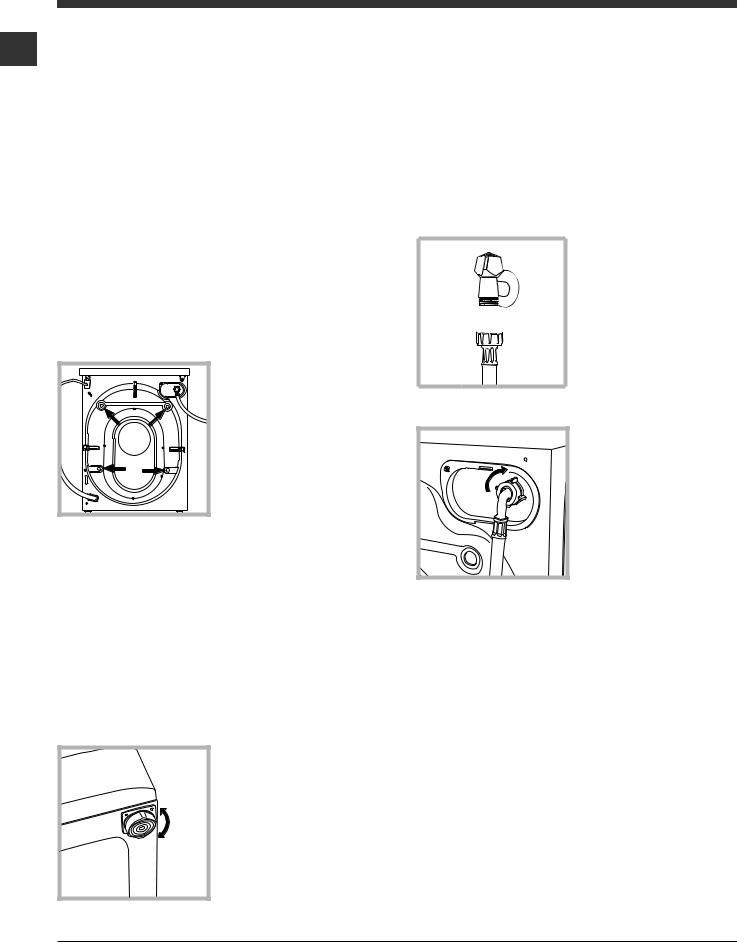
Installation
! This instruction manual should be kept in a safe GB place for future reference. If the washing machine is sold, transferred or moved, make sure that the instruction manual remains with the machine so that the new owner is able to familiarise himself/
herself with its operation and features.
! Read these instructions carefully: they contain vital information relating to the safe installation and operation of the appliance.
Unpacking and levelling
Unpacking
1.Remove the washing machine from its packaging.
2.Make sure that the washing machine has not been damaged during the transportation process. If it has been damaged, contact the retailer and do not proceed any further with the installation process.
3.Remove the 4
protective screws (used during transportation) and the rubber washer with the corresponding spacer, located on the rear part of the
appliance (see figure).
4.Close off the holes using the plastic plugs provided.
5.Keep all the parts in a safe place: you will need them again if the washing machine needs to be moved to another location.
! Packaging materials should not be used as toys for children.
Levelling
1. Install the washing machine on a flat sturdy floor, without resting it up against walls, furniture cabinets or anything else.
2. If the floor is not perfectly level, compensate for any unevenness
by tightening or
loosening the adjustable front feet (see figure); the angle of inclination, measured in relation
to the worktop, must
not exceed 2°.
Levelling the machine correctly will provide it with stability, help to avoid vibrations and excessive noise and prevent it from shifting
while it is operating. If it is placed on carpet or a rug, adjust the feet in such a way as to allow a sufficient ventilation space underneath the washing machine.
Connecting the electricity and water supplies
Connecting the water inlet hose
1. Connect the inlet hose by screwing it to a cold water tap using a 3/4 gas threaded connection (see figure).
Before performing the connection, allow the water to run freely until it is perfectly clear.
2. Connect the inlet hose to the
washing machine by
screwing it onto the
corresponding water inlet of the appliance, which is situated on
the top right-hand side of the rear part of the appliance (see
figure).
3. Make sure that the hose is not folded over or bent.
!The water pressure at the tap must fall within the range of values indicated in the Technical data table (see next page).
!If the inlet hose is not long enough, contact a specialised shop or an authorised technician.
!Never use second-hand hoses.
!Use the ones supplied with the machine.
2
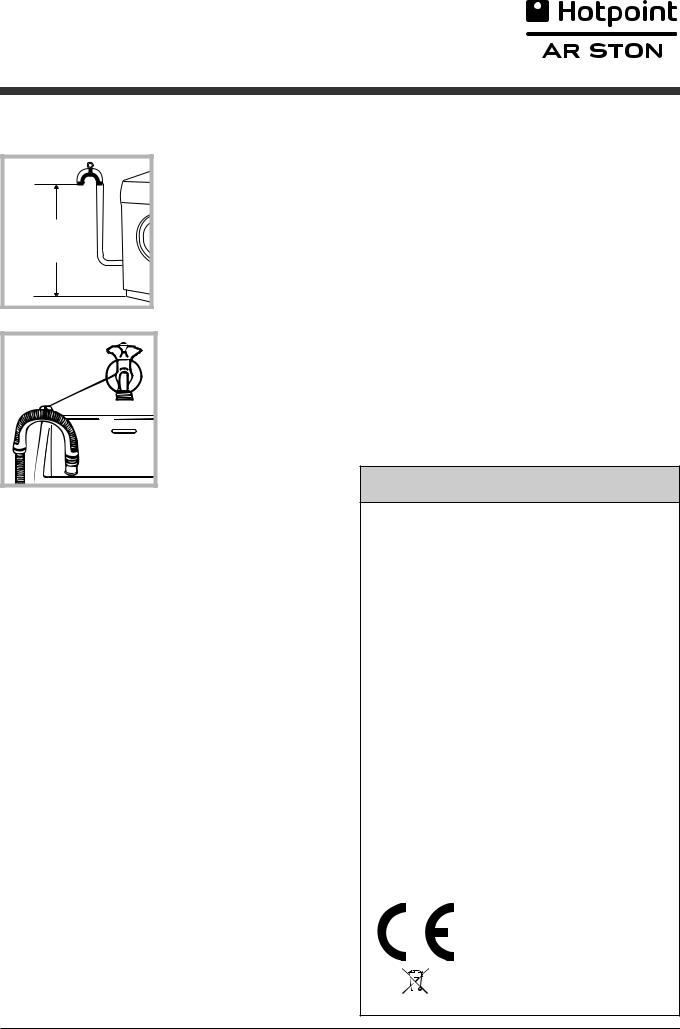
Connecting the drain hose
65 - 100 cm |
Connect the drain hose, without bending it, to a drain duct or a wall drain situated between 65 and 100 cm from the floor;
alternatively, placed it over the edge
of a basin, sink or tub, fastening the duct supplied to the tap (see figure). The free end of the hose should not be underwater.
! We advise against the use of hose extensions; if it is absolutely necessary, the extension must have the same diameter as the original hose and must not exceed 150 cm in length.
Electrical connections
Before plugging the appliance into the electricity socket, make sure that:
•the socket is earthed and complies with all applicable laws;
•the socket is able to withstand the maximum power load of the appliance as indicated in the Technical data table (see
opposite);
• the power supply voltage falls within the values indicated in the Technical data table (see opposite);
• the socket is compatible with the plug of the washing machine. If this is not the case, replace the socket or the plug.
! The washing machine must not be installed outdoors, even in covered areas. It is extremely dangerous to leave the appliance exposed to rain, storms and other weather conditions.
|
|
|
|
! When the washing machine has been |
|
||
GB |
|||
installed, the electricity socket must remain |
|||
|
|||
within easy reach. |
|
||
! Do not use extension cords or multiple |
|
||
sockets. |
|
||
! The cable should not be bent or |
|
||
compressed. |
|
||
! The power supply cable must only be |
|
||
replaced by authorised technicians. |
|
||
Warning! The company shall not be held |
|
||
responsible in the event that these standards |
|
||
are not observed. |
|
||
The first wash cycle |
|
||
Once the appliance has been installed, and |
|
||
before you use it for the first time, run a wash |
|
||
cycle with detergent and no laundry, using |
|
||
wash cycle number auto clean (see “Cleaning |
|
||
the washing machine”). |
|
||
Technical data
Model |
FMSGN 623 |
|||
|
|
|
|
|
Dimensions |
width 59.5 cm |
|||
height 85 cm |
||||
|
|
|
depth 42,5 cm |
|
Capacity |
from 1 to 6 kg |
|||
|
|
|
|
|
Electrical |
please refer to the technical |
|||
data plate fixed to the ma- |
||||
connections |
||||
chine |
||||
|
|
|
maximum pressure |
|
Water con- |
1 MPa (10 bar) |
|||
nections |
minimum pressure |
|||
0.05 MPa (0.5 bar) |
||||
|
|
|
drum capacity 40 litres |
|
Spin speed |
up to 1200 rotations per |
|||
minute |
||||
Test wash |
|
|||
cycles in |
programme 4; |
|||
accordan- |
||||
Cotton Standard 60°C. |
||||
ce with |
||||
programme 5; |
||||
directives |
||||
Cotton Standard 40°C. |
||||
1061/2010 |
||||
1015/2010 |
|
|||
|
|
|
This appliance conforms to |
|
|
|
|
the following EC Directives: |
|
|
|
|
- 2004/108/EC (Electroma- |
|
|
|
|
gnetic Compatibility) |
|
|
|
|
- 2006/95/EC (Low Voltage) |
|
|
|
|
- 2012/19/EU |
|
|
|
|
|
|
3
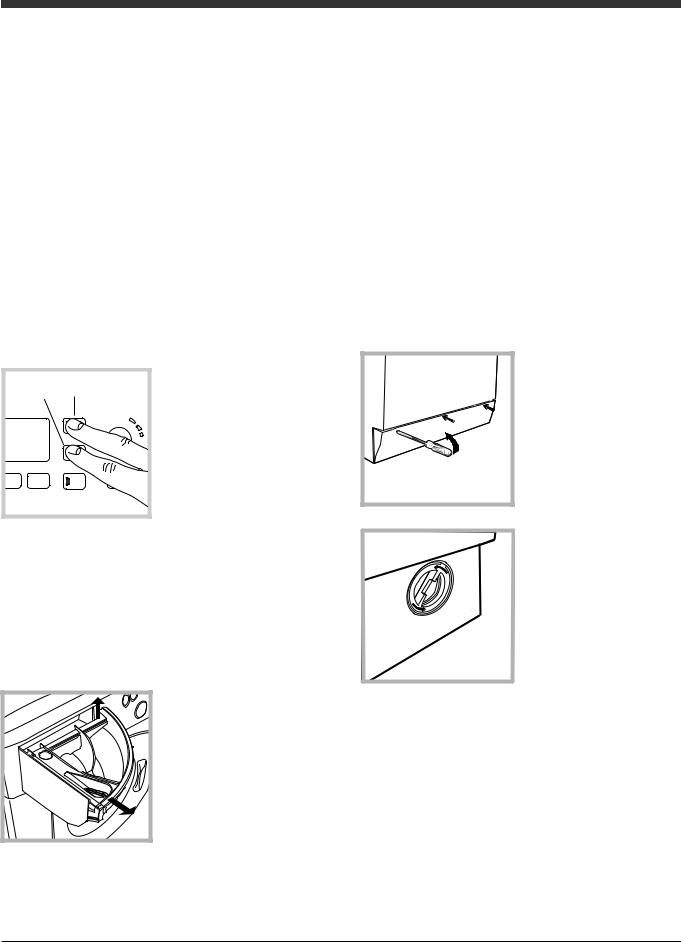
Care and maintenance
|
Cutting off the water and |
|
GB |
||
electricity supplies |
||
|
• Turn off the water tap after every wash cycle. |
|
|
This will limit wear on the hydraulic system |
|
|
inside the washing machine and help to |
|
|
prevent leaks. |
|
|
• Unplug the washing machine when cleaning |
|
|
it and during all maintenance work. |
|
|
Cleaning the washing machine |
•The outer parts and rubber components of the appliance can be cleaned using a soft cloth soaked in lukewarm soapy water. Do not use solvents or abrasives.
•The washing machine has a auto clean programme for its internal parts that must be
run with no load in the drum.
A B |
To help the wash cycle |
you may want to use |
|
|
either the detergent |
|
(i.e. a quantity 10% |
|
the quantity specified |
|
for lightly-soiled |
|
garments) or special |
|
additives to clean the |
|
washing machine. We |
|
recommend running a |
cleaning programme every 40 wash cycles. To start the programme press buttons A and B simultaneously for 5 seconds (see figure).
The programme will start automatically and will run for about 70 minutes. To stop the cycle press the START/PAUSE button.
Cleaning the detergent dispenser drawer
1 |
2 |
Remove the dispenser by raising it and pulling it out (see figure).
Wash it under running water; this operation should be repeated frequently.
Caring for the door and drum of your appliance
•Always leave the porthole door ajar in order to prevent unpleasant odours from forming.
Cleaning the pump
The washing machine is fitted with a selfcleaning pump which does not require any maintenance. Sometimes, small items (such as coins or buttons) may fall into the pre-chamber which protects the pump, situated in its bottom part.
! Make sure the wash cycle has finished and unplug the appliance.
To access the pre-chamber:
1. using a screwdriver, remove the cover panel on the lower front part of the washing machine
(see figure);
2. unscrew the lid by rotating it anti-
clockwise (see figure): a little water may trickle out. This is perfectly normal;
3.clean the inside thoroughly;
4.screw the lid back on;
5.reposition the panel, making sure the hooks are securely in place before you push it onto the appliance.
Checking the water inlet hose
Check the inlet hose at least once a year. If there are any cracks, it should be replaced immediately: during the wash cycles, water pressure is very strong and a cracked hose could easily split open.
! Never use second-hand hoses.
4
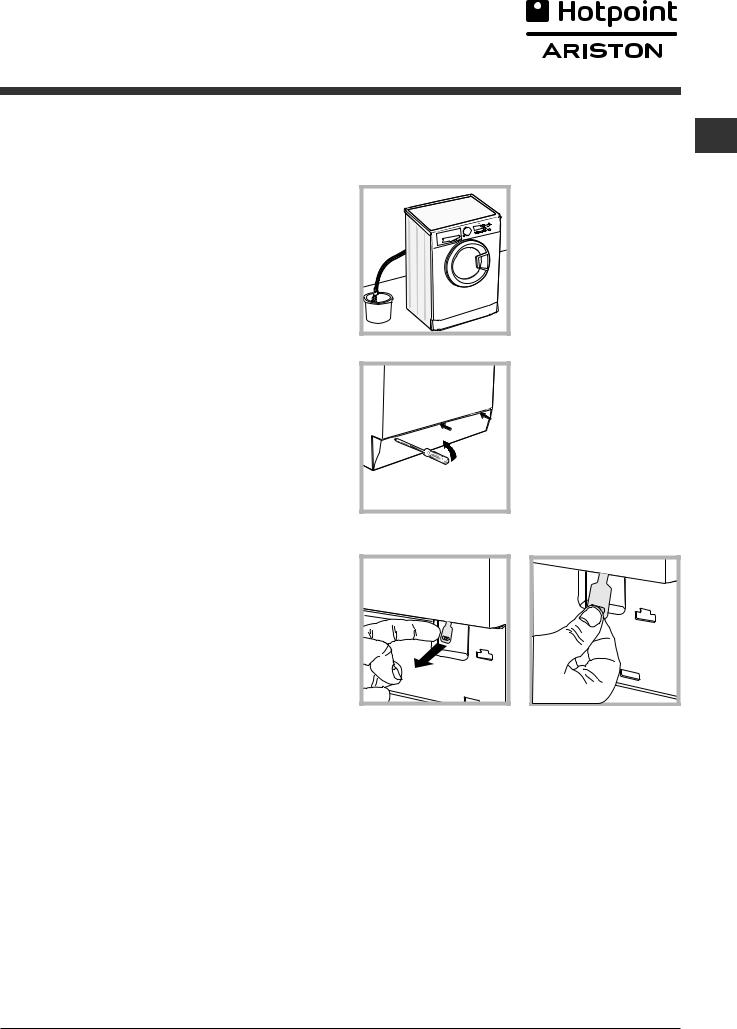
Precautions and tips
! This washing machine was designed and constructed in accordance with international safety regulations. The following information is provided for safety reasons and must therefore be read carefully.
General safety
•This appliance was designed for domestic use only.
•This appliance can be used by children
aged from 8 years and above and persons with reduced physical, sensory or mental capabilities or lack of experience and knowledge if they have been given supervision or instruction concerning use of the appliance in a safe way and understand the hazards involved. Children shall not play with the appliance. Cleaning and user maintenance shall not be made by children without supervision.
•Do not touch the machine when barefoot or with wet or damp hands or feet.
•Do not pull on the power supply cable when unplugging the appliance from the electricity socket. Hold the plug and pull.
•Do not open the detergent dispenser drawer while the machine is in operation.
•Do not touch the drained water as it may reach extremely high temperatures.
•Never force the porthole door. This could damage the safety lock mechanism designed to prevent accidental opening.
•If the appliance breaks down, do not under any circumstances access the internal mechanisms in an attempt to repair it yourself.
•Always keep children well away from the appliance while it is operating.
•The door can become quite hot during the wash cycle.
•If the appliance has to be moved, work in a group of two or three people and handle it with the utmost care. Never try to do this alone, because the appliance is very heavy.
•Before loading laundry into the washing machine, make sure the drum is empty.
Disposal
•Disposing of the packaging materials: observe local regulations so that the packaging may be re-used.
•The European Directive 2012/19/EU on Waste Electrical and Electronic Equipment, requires that old household electrical appliances must not be disposed of in the normal unsorted municipal waste stream. Old appliances must be collected separately in order to optimise the recovery and recycling of the materials they contain and reduce the impact on human health and the environment. The crossed out “wheeled bin” symbol on the product reminds you of your obligation, that when you dispose of the appliance it must be separately collected. Consumers should contact their local authority or retailer for information concerning the correct disposal of their old appliance.
Opening the porthole door manually |
GB |
|
In the event that it is not possible to open the porthole |
||
|
||
door due to a powercut, and if you wish to remove the |
|
|
laundry, proceed as follows: |
|
|
1. remove the plug from the |
|
|
electrical socket. |
|
|
2. make sure the water level |
|
|
inside the machine is lower |
|
|
than the door opening; if |
|
|
it is not, remove excess |
|
|
water using the drain hose, |
|
|
collecting it in a bucket as |
|
|
indicated in the figure. |
|
|
3. using a screwdriver, |
|
|
remove the cover panel on |
|
|
the lower front part of the |
|
|
washing machine (see figure). |
|
4.pull outwards using the tab as indicated in the figure, until the plastic tie-rod is freed from its stop position; pull downwards and open the door at the same time.
5.reposition the panel, making sure the hooks are securely in place before you push it onto the appliance.
5
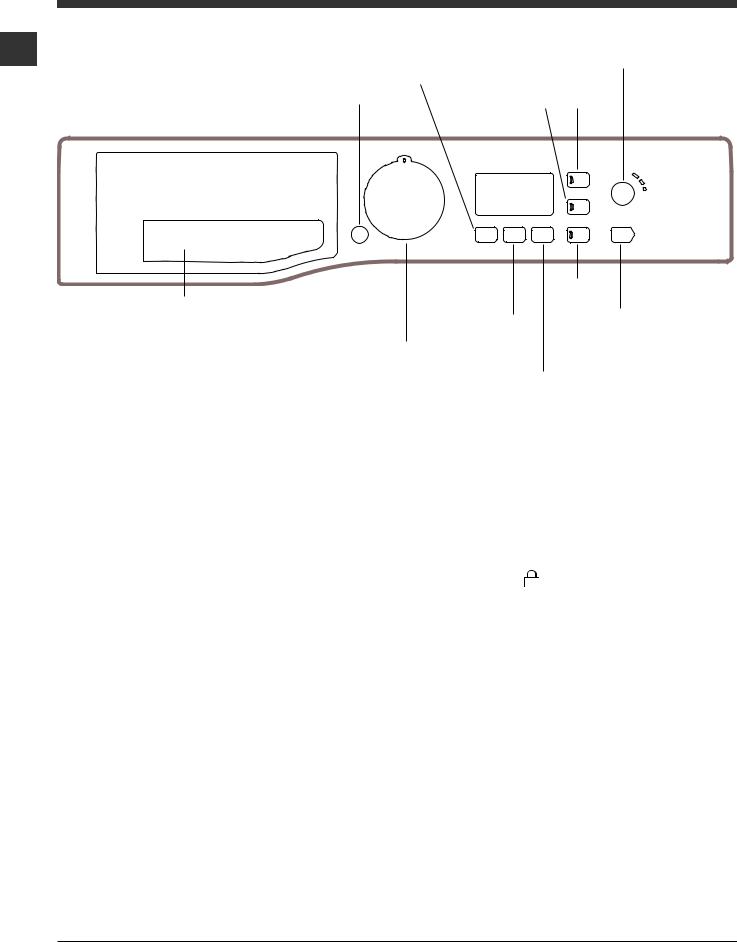
Description of the washing machine
Control panel
GB
TEMPERATURE |
OPTION |
CLEANING |
|
button |
|||
buttons and |
ACTION |
||
|
|||
|
indicator lights |
button |
ON/OFF button
DISPLAY
|
|
|
CHILD |
START/PAUSE |
|
|
SPIN |
button and indicator |
|
Detergent dispenser drawer |
WASH |
LOCK |
light |
|
CYCLE |
button |
button |
|
|
|
SELECTOR |
|
|
|
|
KNOB |
|
DELAY |
|
|
|
|
TIMER |
|
|
|
|
button |
|
Detergent dispenser drawer: used to dispense detergents and washing additives (see “Detergents and laundry”).
ON/OFF  button: press this briefly to switch the machine on or off. The START/PAUSE indicator light which flashes slowly in a green colour shows that the machine is switched on. To switch off the washing machine during the wash cycle, press and hold the button for approximately 3 seconds; if the button is pressed briefly or accidentally the machine will not switch off.
button: press this briefly to switch the machine on or off. The START/PAUSE indicator light which flashes slowly in a green colour shows that the machine is switched on. To switch off the washing machine during the wash cycle, press and hold the button for approximately 3 seconds; if the button is pressed briefly or accidentally the machine will not switch off.
If the machine is switched off during a wash cycle, this wash cycle will be cancelled.
WASH CYCLE SELECTOR KNOB: used to set the desired wash cycle (see “Table of programmes and wash cycles”).
OPTION buttons and indicator lights: press to select the available options. The indicator light corresponding to the selected option will remain lit.
CLEANING ACTION button  : to select the desired wash intensity.
: to select the desired wash intensity.
TEMPERATURE  button: press to reduce or completely exclude the temperature; the value appears on the display.
button: press to reduce or completely exclude the temperature; the value appears on the display.
SPIN  button: press to reduce or completely exclude the spin cycle; the value appears on the display.
button: press to reduce or completely exclude the spin cycle; the value appears on the display.
DELAYED START  button: press to set a delayed start for the selected wash cycle; the delay period appears on the display.
button: press to set a delayed start for the selected wash cycle; the delay period appears on the display.
START/PAUSE button and indicator light: when the green indicator light flashes slowly, press the button to start a wash cycle. Once the cycle has begun the indicator light will remain lit in a fixed manner. To pause the wash cycle, press the button again; the indicator light will flash in an amber colour. If the symbol is not illuminated, the door may be opened. To start the wash cycle from the point at which it was interrupted, press the button again.
CHILD LOCK button: to activate the control panel lock, press and hold the button for approximately 2 seconds. When the symbol  is illuminated, the control panel is locked (apart from the ON/OFF button). This means it is possible to prevent wash cycles from being modified accidentally, especially where there are children in the
is illuminated, the control panel is locked (apart from the ON/OFF button). This means it is possible to prevent wash cycles from being modified accidentally, especially where there are children in the
home. To deactivate the control panel lock, press and hold the button for approximately 2 seconds.
Standby mode
This washing machine, in compliance with new energy saving regulations, is fitted with an automatic standby system which is enabled after about 30 minutes if no activity is detected. Press the ON-OFF button briefly and wait for the machine to start up again.
6
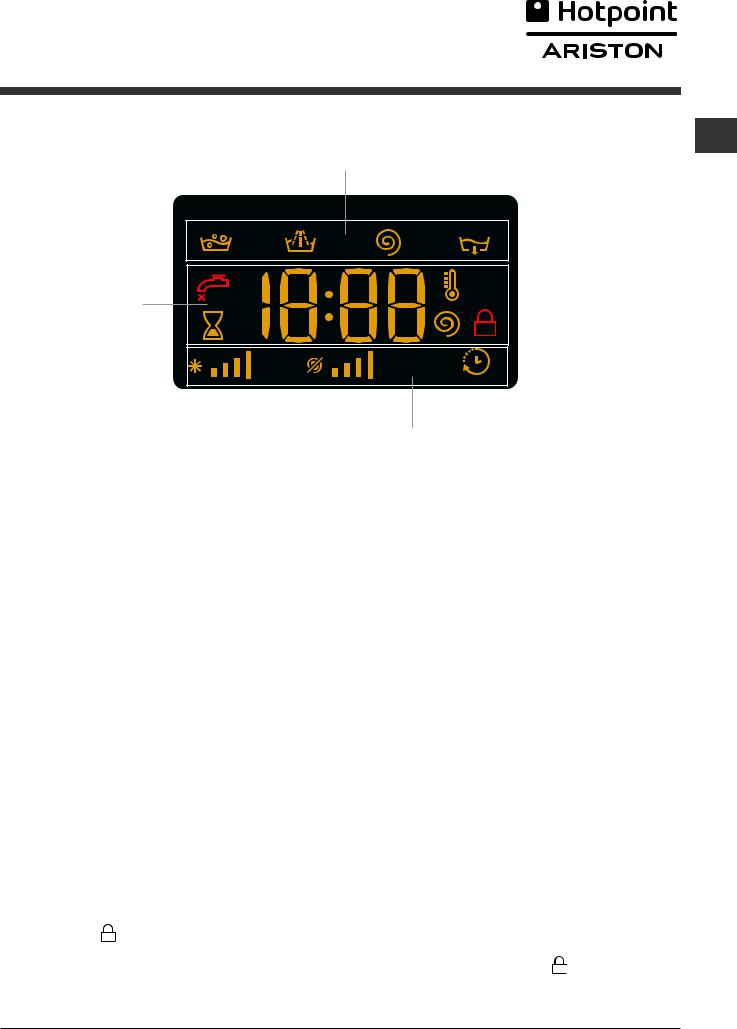
Display |
GB |
|
B
A
C
The display is useful when programming the machine and provides a great deal of information.
The duration of the available wash cycles and the remaining time of a running cycle appear in section A (the display will show the maximum duration of the cycle chosen, which may decrease after several minutes, since the effective duration of the programme varies depending on the wash load and the settings chosen); if the DELAYED START option has been set, the countdown to the start of the selected wash cycle will appear.
Pressing the corresponding button allows you to view the maximum spin speed and temperature values attained by the machine during the set wash cycle, or the values selected most recently, if these are compatible with the set wash cycle.
The “wash cycle phases” corresponding to the selected wash cycle and the “wash cycle phase” of the running wash cycle appear in section B:
 Main wash
Main wash
 Rinse
Rinse
 Spin
Spin  Pump out
Pump out
The icons corresponding to “temperature”, “spin” and “delayed start” (working from the left) are displayed in section C. The “temperature” bars



 indicate the maximum temperature level which may be selected for the set cycle.
indicate the maximum temperature level which may be selected for the set cycle.
The “spin” bars 



 indicate the maximum spin level which may be selected for the set cycle.
indicate the maximum spin level which may be selected for the set cycle.
The “delay” symbol  , when lit, indicates that the set “delayed start” value has appeared on the display.
, when lit, indicates that the set “delayed start” value has appeared on the display.
DOOR LOCKED indicator light:
The lit symbol indicates that the door is locked. To prevent any damage, wait until the symbol turns off before opening the door. To open the door while a cycle is in progress, press the START/PAUSE button; if the DOOR LOCKED symbol is switched off the door may be opened.
7

Running a wash cycle
1. SWITCH THE MACHINE ON. Press the  button;
button;
GB the START/PAUSE indicator light will flash slowly in a green colour.
2.LOAD THE LAUNDRY. Open the porthole door. Load the laundry, making sure you do not exceed the maximum load value indicated in the table of programmes and wash cycles on the following page.
3.MEASURE OUT THE DETERGENT. Pull out the detergent dispenser drawer and pour the detergent into the relevant compartments as described in “Detergents and laundry”.
4.CLOSE THE DOOR.
5.SELECT THE WASH CYCLE. Use the WASH CYCLE SELECTOR knob to select the desired wash cycle. A temperature and spin speed is set for each wash cycle; these values may be adjusted. The duration of the cycle will appear on the display.
6.CUSTOMISE THE WASH CYCLE. Use the relevant buttons:
Modify the temperature and/or spin speed.
The machine automatically displays the maximum temperature and spin speed values set for the selected cycle, or the most recently-used settings if they are compatible with the selected cycle. The temperature
can be decreased by pressing the button, until the cold wash “OFF” setting is reached. The spin speed may be progressively reduced by pressing the  button, until it is completely excluded (the
button, until it is completely excluded (the
“OFF” setting). If these buttons are pressed again, the maximum values are restored.
! Exception: if the 4 programme is selected, the temperature can be increased up to a value of 90°C.
Setting a delayed start.
To set a delayed start for the selected cycle, press the corresponding button repeatedly until the required delay period has been reached. When this option has been activated, the  symbol lights up on the display. To remove the delayed start setting, press the button until the text “OFF” appears on the display.
symbol lights up on the display. To remove the delayed start setting, press the button until the text “OFF” appears on the display.
Set the desired wash intensity.
Option  makes it possible to optimise washing based on the level of soil in the fabrics and on desired wash cycle intensity.
makes it possible to optimise washing based on the level of soil in the fabrics and on desired wash cycle intensity.
Select the wash programme: the cycle will be automatically set to “Normal” as optimised for garments with an average level of soil (this setting is not applicable to the “Wool” cycle, which is automatically set to “Delicate”).
For heavily-soiled garments press  button until the “Intensive” level is reached. This level ensures a high-performance wash due to a larger quantity of
button until the “Intensive” level is reached. This level ensures a high-performance wash due to a larger quantity of
water used in the initial phase of the cycle and due to increased drum rotation. It is useful when removing the most stubborn stains.
It can be used with or without bleach. If you desire bleaching, insert the extra tray compartment (4) into compartment 1. When pouring in the bleach, be careful not to exceed the “max” level marked on the central pivot (see figure pag. 10).
For lightly-soiled garments or a more delicate treatment of the fabrics, press  button until the “Delicate” level is reached. The cycle will reduce drum rotation to ensure washing results that are perfect for delicate garments.
button until the “Delicate” level is reached. The cycle will reduce drum rotation to ensure washing results that are perfect for delicate garments.
Modify the cycle settings.
•Press the button to enable the option; the indicator light corresponding to the button will switch on.
•Press the button again to disable the option; the indicator light will switch off.
!If the selected option is not compatible with the set wash cycle, the indicator light will flash and the option will not be activated.
!If the selected option is not compatible with a previously selected one, the indicator light corresponding to the first function selected will flash and only the second option will be activated; the indicator light for the option which has been activated will be illuminated.
!The options may affect the recommended load value and/or the duration of the cycle.
7.START THE WASH CYCLE. Press the START/ PAUSE button. The corresponding indicator light will turn green, remaining lit in a fixed manner, and the
door will be locked (the DOOR LOCKED symbol will be lit). To change a wash cycle while it is in progress, pause the washing machine using the START/PAUSE button (the START/PAUSE indicator light will flash slowly in an amber colour); then select the desired cycle and press the START/PAUSE button again.
To open the door while a cycle is in progress, press the START/PAUSE button; if the DOOR LOCKED symbol is switched off the door may be opened. Press the START/PAUSE button again to restart the wash cycle from the point at which it was interrupted.
8.THE END OF THE WASH CYCLE. This will be indicated by the text “END” on the display; when the
DOOR LOCKED symbol switches off the door may be opened. Open the door, unload the laundry and switch off the machine.
! If you wish to cancel a cycle which has already begun, press and hold the  button. The cycle will be stopped and the machine will switch off.
button. The cycle will be stopped and the machine will switch off.
8
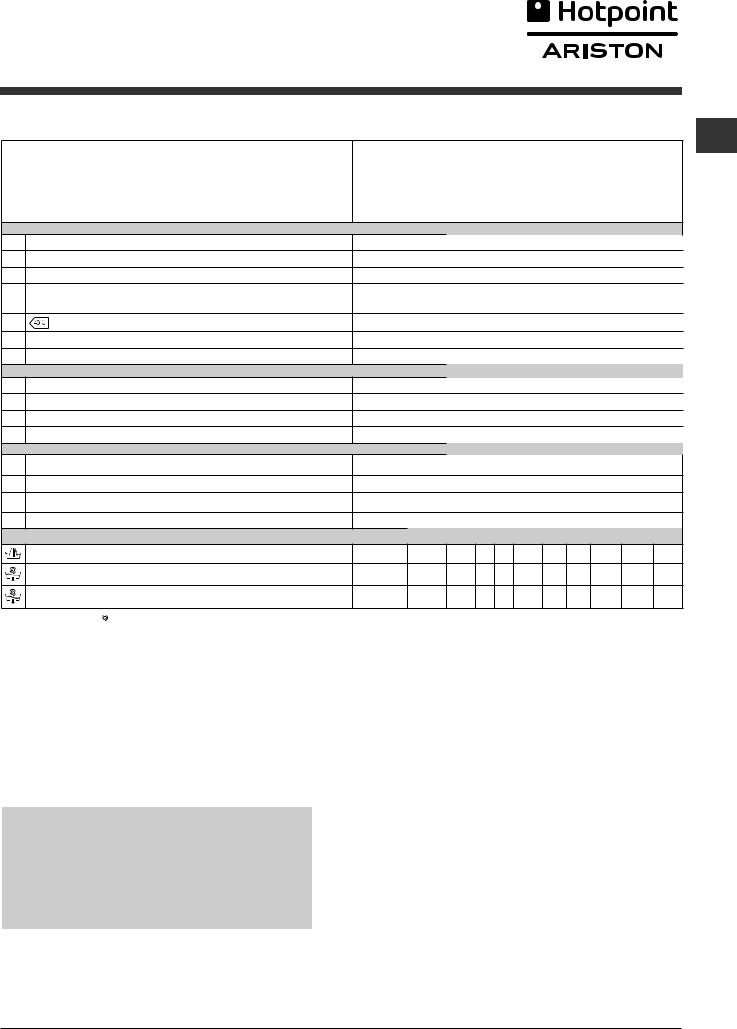
Wash cycles and options
Table of programmes and wash cycles
cycles |
Description of the wash cycle |
|
Wash |
||
|
||
|
|
CLEAN Plus
1Anti Stain
2 Anti Stain Quick
3Whites
4 Cotton Standard 60°C (1): heavily soiled whites and resistant colours.
Cotton Standard 60°C (1): heavily soiled whites and resistant colours.
5 |
Cotton Standard 40°C (2): lightly soiled resistant and delicate colours. |
6Synthetics: heavily soiled resistant colours.
6Synthetics (4): lightly soiled resistant colours.
SPECIALS
7Anti allergy Plus
8Anti allergy Delicate
9 Wool: for wool, cashmere, etc.
10 Delicates
ECO
11 Cotton Standard 20°C: lightly soiled resistant and delicate colours.
12Eco Cottons
13Eco Synthetics
14Eco Fast 30’
Partial Programmes
GB
|
|
Prewash |
|
Wash Bleach Fabric softener |
(kg)loadMax. |
-damResidual pness% |
-conEnergy sumptionkWh |
ltwaterTotal |
durationCycle |
||
|
|
|
Detergents |
|
|
|
|
|
|||
Max. |
Max. |
|
|
|
|
|
|
|
|
|
|
|
|
|
|
|
|
|
|
|
|
||
temp. |
speed |
|
|
|
|
|
|
|
|
|
|
(°C) |
(rpm) |
|
|
|
|
|
|
|
|
|
|
|
|
|
|
|
|
|
|
|
|
|
|
40° |
1200 |
|
|
- |
|
3 |
- |
- |
- |
170’ |
40° |
1200 |
- |
|
- |
|
2,5 |
- |
- |
- |
60’ |
60° |
1200 |
|
|
- |
|
3 |
- |
- |
- |
165’ |
60° |
1200 |
(3) |
|
|
|
6 |
53 |
0.78 |
50 |
200’ |
(Max. 90°) |
||||||||||
40° |
1200 |
- |
|
|
|
6 |
53 |
0.65 |
65 |
170’ |
60° |
800 |
|
|
|
|
3 |
44 |
0.70 |
44 |
105’ |
40° |
800 |
|
|
|
|
3 |
44 |
0.47 |
38 |
95’ |
|
|
|
|
|
|
|
|
|
|
|
60° |
1200 |
- |
|
|
|
3 |
- |
- |
- |
165’ |
40° |
1200 |
- |
|
|
|
3 |
- |
- |
- |
180’ |
40° |
800 |
- |
|
- |
|
1 |
- |
- |
- |
65’ |
30° |
0 |
- |
|
- |
|
0,5 |
- |
- |
- |
75’ |
|
|
|
|
|
|
|
|
|
|
|
20° |
1200 |
- |
|
|
|
6 |
- |
- |
- |
170’ |
Cold Water |
1200 |
- |
|
- |
|
6 |
53 |
0.15 |
54 |
80’ |
Cold Water |
800 |
- |
|
- |
|
2,5 |
48 |
0.06 |
25 |
70’ |
Cold Water |
800 |
- |
|
- |
|
2,5 |
71 |
0.04 |
32 |
30’ |
Rinse |
- |
1200 |
- |
- |
- |
|
6 |
- |
- |
- |
36’ |
Spin and Pump out |
- |
1200 |
- |
- |
- |
- |
6 |
- |
- |
- |
10’ |
Pump out only * |
- |
OFF |
- |
- |
- |
- |
6 |
- |
- |
- |
3’ |
* If you select programme  and exclude the spin cycle, the machine will drain only.
and exclude the spin cycle, the machine will drain only.
The length of cycle shown on the display or in this booklet is an estimation only and is calculated assuming standard working conditions. The actual duration can vary according to factors such as water temperature and pressure, the amount of detergent used, the amount and type of load inserted, load balancing and any wash options selected.
1) Test wash cycle in compliance with directive 1061/2010: set wash cycle 4 with a temperature of 60°C.
This cycle is designed for cotton loads with a normal soil level and is the most efficient in terms of both electricity and water consumption; it should be used for garments which can be washed at 60°C . The actual washing temperature may differ from the indicated value.
2) Test wash cycle in compliance with directive 1061/2010: set wash cycle 5 with a temperature of 40°C.
This cycle is designed for cotton loads with a normal soil level and is the most efficient in terms of both electricity and water consumption; it should be used for garments which can be washed at 40°C . The actual washing temperature may differ from the indicated value.
3) At 60 °C the “Prewash” function cannot be selected.
For all Test Institutes:
2) Long wash cycle for cottons: set wash cycle 5 with a temperature of 40°C. 4) Long wash cycle for synthetics: set wash cycle 6 with a temperature of 40°C.
Wash options
!If the selected option is not compatible with the set wash cycle, the indicator light will flash and the option will not be activated.
!If the selected option is not compatible with a previously selected one, the indicator light corresponding to the first function selected will flash and only the second option will be activated; the indicator light for the option which has been activated will be illuminated.
 Extra Rinse
Extra Rinse
By selecting this option, the efficiency of the rinse is increased and optimal detergent removal is guaranteed. It is particularly useful for sensitive skin.
 Prewash
Prewash
If this function is selected, the pre-wash cycle will run; this is useful for removing stubborn stains.
N.B.: Put the detergent in the relevant compartment.
9

Detergents and laundry
|
Detergent dispenser drawer |
|
GB |
||
Successful washing results also depend on the correct |
||
|
||
|
dose of detergent: adding too much detergent will not |
|
|
necessarily result in a more efficient wash, and may in |
|
|
fact cause build up on the inside of your appliance and |
|
|
contribute to environmental pollution. |
|
|
! Use powder detergent for white cotton garments, for pre- |
|
|
washing, and for washing at temperatures over 60°C. |
|
|
! Follow the instructions given on the detergent packaging. |
|
|
! Do not use hand washing detergents; they create too |
|
|
much foam. |
B
4
MAX
 1
1
3
AOpen the detergent dispenser drawer and pour in the detergent or washing additive, as follows.
2 |
compartment 1: Pre- |
wash detergent (powder) |
|
|
Before pouring in the |
|
detergent, make sure that |
|
extra compartment 4 has |
|
been removed. |
compartment 2: Detergent for the wash cycle (powder or liquid)
If liquid detergent is used, it is recommended that the removable plastic partition A (supplied) be used for proper dosage.
If powder detergent is used, place the partition into slot B. compartment 3: Additives (fabric softeners, etc.)
The fabric softener should not overflow the grid. extra compartment 4: Bleach
Preparing the laundry
•Divide the laundry according to:
-the type of fabric/the symbol on the label
-the colours: separate coloured garments from whites.
•Empty all garment pockets and check the buttons.
•Do not exceed the listed values, which refer to the weight of the laundry when dry: see “Table of programmes and wash cycles”.
How much does your laundry weigh?
1 sheet 400-500 g
1 pillow case 150-200 g
1 tablecloth 400-500 g
1 bathrobe 900-1,200 g
1 towel 150-250 g
Special wash cycles
Anti Stain: the programme 1 is suitable to heavily-soiled garments with resistant colours. It ensures a washing class that is higher than the standard class (A class).
When running the programme, do not mix garments of different colours. We recommend the use of powder detergent. Pre-treatment with special additives is recommended if there are obstinate stains.
Anti Stain Quick: this programme is ideal for washing the most difficult daily stains in 1 hour. It is ideal for mixed fabrics and coloured garments, caring for your clothes as it washes.
Whites: use this cycle 3 to wash white clothes. The programme is designed to maintain the brightness of white clothes over time. Use powder detergent for best results. Anti allergy Plus: use programme 7 to remove major allergens such as pollen, mites, cat’s and dog’s hair.
Anti allergy Delicate: cycle studied for cotton laundry and other resistant fabrics to guarantee the removal of pollen and cat and dog hair already at 40°.
Wool: the wool wash cycle of this machine has been approved by The Woolmark Company for the washing of wool garments labelled as “hand wash” provided that the products are washed according to the instructions on the garment label and those issued by the manufacturer of this washing machine (M1128)
Delicates: use programme 10 to wash very delicate garments having strasses or sequins.
To wash silk garments and curtains select the cycle 10 and set the “Delicate” level from option  .
.
We recommend turning the garments inside out before washing and placing small items into the special bag for washing delicates. Use liquid detergent on delicate garments for best results.
Eco cycles
The Eco Cycles assure energy saving by eliminating the need of heating water and it’s an advantage both to your energy bill and the environment! These innovative Eco programmes (12 Eco Cottons, 13 Eco Synthetics and 14 Eco Fast 30’) are available for various fabrics and different quantity of garment; they have been designed to guarantee a high cleaning action even at low temperature and can be used for lightly to medium soiled loads. Eco Cycles give the best results thanks to an intensified wash action, water optimization and are carried out in the same average time of a standard cycle. For the best washing results with Eco Cycles we recommend the usage of a liquid detergent.
Cotton Standard 20°C ideal for lightly soiled cotton loads. The effective performance levels achieved at cold temperatures, which are comparable to washing at 40°, are guaranteed by a mechanical action which operates at varying speed, with repeated and frequent peaks.
Load balancing system
Before every spin cycle, to avoid excessive vibrations before every spin and to distribute the load in a uniform manner, the drum rotates continuously at a speed which is slightly greater than the washing rotation speed. If, after several attempts, the load is not balanced correctly, the machine spins at a reduced spin speed. If the load is excessively unbalanced, the washing machine performs the distribution process instead of spinning. To encourage improved load distribution and balance, we recommend small and large garments are mixed in the load.
10

Troubleshooting
|
|
|
|
|
|
|
|
|
|
|
|
|
|
|
Your washing machine could occasionally fail to work. Before contacting the Technical Assistance Service (see “ Service”), |
|
|||
GB |
||||
make sure that the problem cannot be solved easily using the following list. |
||||
|
||||
|
|
|
|
|
Problem:
The washing machine does not switch on.
The wash cycle does not start.
Possible causes / Solutions:
•The appliance is not plugged into the socket fully, or not enough to make contact.
•There is no power in the house.
•The washing machine door is not closed properly.
•The ON/OFF button has not been pressed.
•The START/PAUSE button has not been pressed.
•The water tap has not been opened.
•A delayed start has been set.
The washing machine does not fill with water (the text “H2O” flashes on the display).
The washing machine continuously takes in and drains water.
The washing machine does not drain or spin.
•The water inlet hose is not connected to the tap.
•The hose is bent.
•The water tap has not been opened.
•There is no water supply in the house.
•The pressure is too low.
•The START/PAUSE button has not been pressed.
•The drain hose is not fitted at a height between 65 and 100 cm from the floor (see “Installation”).
•The free end of the hose is under water (see “Installation”).
•The wall drainage system is not fitted with a breather pipe.
If the problem persists even after these checks, turn off the water tap, switch the appliance off and contact the Technical Assistance Service. If the dwelling is on one of the upper floors of a building, there may be problems relating to water drainage, causing the washing machine to fill with water and drain continuously. Special antidraining valves are available in shops and help to prevent this inconvenience.
•The wash cycle does not include draining: some cycles require the draining process to be enabled manually.
•The drain hose is bent (see “Installation”).
•The drainage duct is clogged.
The washing machine vibrates a lot during the spin cycle.
•The drum was not unlocked correctly during installation (see “Installation”).
•The washing machine is not level (see “Installation”).
•The washing machine is trapped between cabinets and walls (see “Installation”).
The washing machine leaks. |
• The water inlet hose is not screwed on properly (see “Installation”). |
|
• The detergent dispenser drawer is blocked (for cleaning instructions, see “Care |
|
and maintenance”). |
|
• The drain hose is not fixed properly (see “Installation”). |
The “option” and START/PAUSE indicator lights flash rapidly and an error code appears on the display (e.g.: F-01, F-..).
There is too much foam.
•Switch off the machine and unplug it, wait for approximately 1 minute and then switch it back on again.
If the problem persists, contact the Technical Assistance Service.
•The detergent is not suitable for machine washing (it should display the text “for washing machines” or “hand and machine wash”, or the like).
•Too much detergent was used.
11
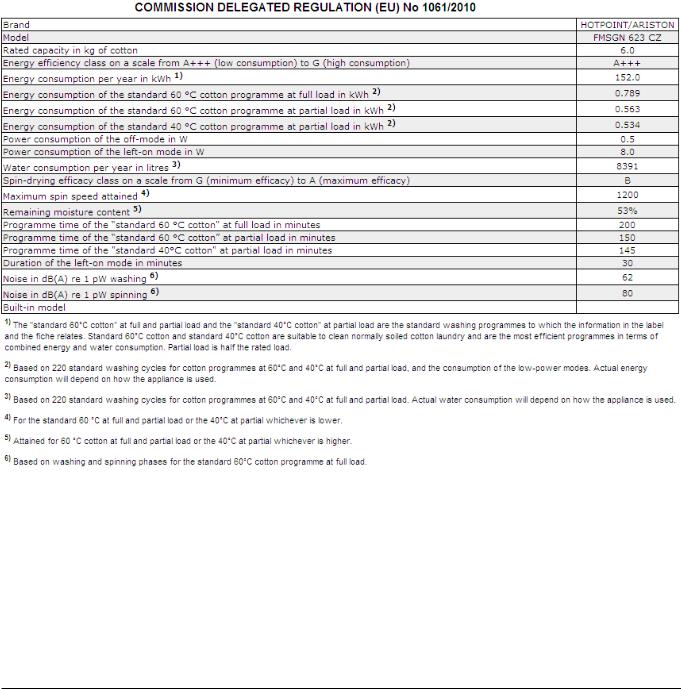
Service
|
|
|
|
|
|
Before contacting the Technical Assistance Service: |
|
GB |
|||
|
• Check whether you can solve the problem alone (see “Troubleshooting”); |
||
|
|
• Restart the wash cycle to check whether the problem has been solved; |
|
|
|||
|
|
• If this is not the case, contact an authorised Technical Assistance Centre. |
|
|
|
! Always request the assistance of authorised technicians. |
Have the following information to hand:
•the type of problem;
•the appliance model (Mod.);
•the serial number (S/N).
This information can be found on the data plate applied to the rear of the washing machine, and can also be found on the front of the appliance by opening the door.
12

Návod k použití
CZ
Česky
FMSGN 623
Obsah
Instalace, 14-15
Rozbalení a vyrovnání do vodorovné polohy Připojení k elektrické a k vodovodní síti První prací cyklus
Technické údaje
PRAČKA
CZ
Údržba a péče, 16
Uzavření přívodu vody a vypnutí elektrického napájení Čištění pračky
Čištění dávkovače pracích prostředků Péče o dvířka a buben
Čištění čerpadla
Kontrola přítokové hadice na vodu
Opatření a rady, 17
Základní bezpečnostní pokyny
Likvidace
Manuální otevření dvířek
Popis pračky, 18-19
Ovládací panel
Displej
Jak provést prací cyklus, 20
Programy a volitelné funkce, 21
Tabulka programů Volitelné funkce praní
Prací prostředky a prádlo, 22
Dávkovač pracích prostředků Příprava prádla
Speciální programy
Systém automatického vyvážení náplně
Poruchy a způsob jejich odstranění, 23 Servisní služba, 24
13
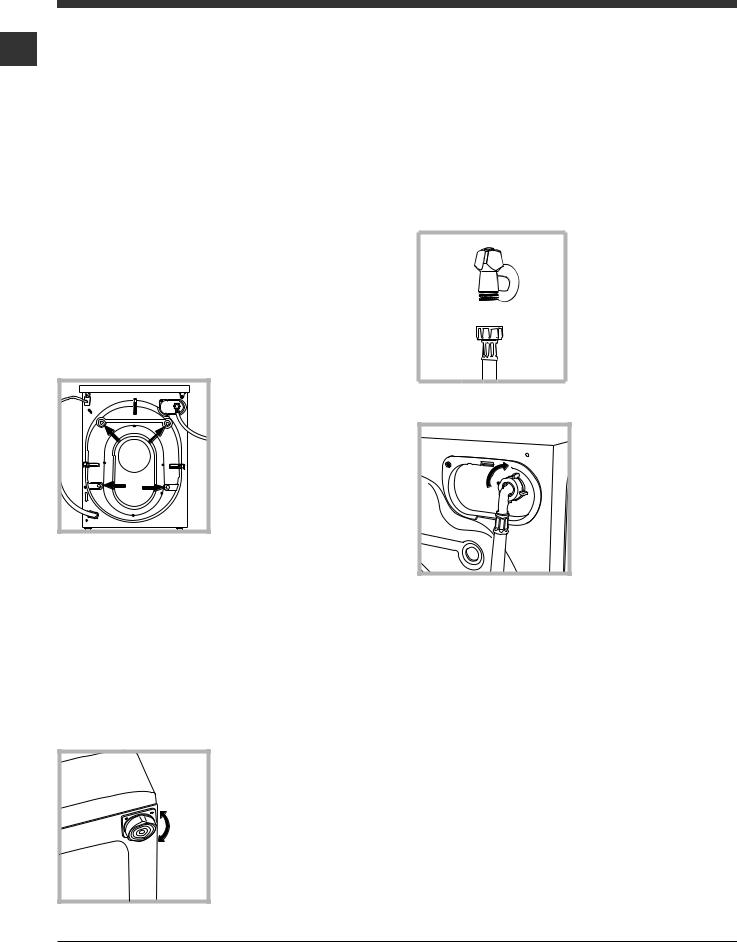
Instalace
! Je důležité uschovat tento návod tak, CZ abyste jej mohli kdykoli konzultovat.
V případě prodeje, darování nebo přestěhování pračky se ujistěte, že zůstane uložen v blízkosti pračky, aby mohl posloužit novému majiteli při seznámení s její činností a s příslušnými upozorněními.
! Pozorně si přečtěte uvedené pokyny: Obsahují důležité informace týkající se instalace, použití a bezpečnosti při práci.
Rozbalení a vyrovnání do vodorovné polohy
Rozbalení
1.Rozbalte pračku.
2.Zkontrolujte, zda během přepravy nedošlo k jejímu poškození. V případě, že je poškozena, ji nezapojujte a obraťte se na prodejce.
3. Odstraňte 4 šrouby chránící před poškozením během přepravy a gumovou podložku s příslušnou rozpěrkou, které se nacházejí v zadní části (viz obrázek).
4.Uzavřete otvory po šroubech plastovými krytkami z příslušenství.
5.Uschovejte všechny díly: v případě opětovné přepravy pračky je bude třeba namontovat zpět.
! Obaly nejsou hračky pro děti!
Vyrovnání do vodorovné polohy
1. Pračku je třeba umístit na rovnou a pevnou podlahu, aniž by se opírala o stěnu, nábytek či něco jiného.
nesmí přesáhnout 2°.
Dokonalé vyrovnání do vodorovné polohy zabezpečí stabilitu zařízení a zamezí vzniku vibrací a hluku během činnosti. V případě instalace na podlahovou krytinu nebo na koberec nastavte nožky tak, aby pod pračkou zůstal dostatečný volný prostor pro ventilaci.
Připojení k elektrické a k vodovodní síti
Připojení přítokové hadice vody
1. Připojte přívodní hadici jejím zašroubováním ke kohoutku studené vody s hrdlem se závitem 3/4” (viz obrázek).
Před připojením hadice nechte vodu odtékat, dokud nebude čirá.
2. Připojte přítokovou hadici k pračce prostřednictvím příslušné přípojky na vodu, umístěné vpravo nahoře (viz obrázek).
3. Dbejte na to, aby hadice nebyla příliš ohnutá ani stlačená.
!Tlak v rozvodu vody se musí pohybovat v rozmezí hodnot uvedených v tabulce s technickými údaji (viz vedlejší strana).
!V případě, že délka přítokové hadice nebude dostatečná, se obraťte na specializovanou prodejnu nebo na autorizovaný technický personál.
!Nikdy nepoužívejte již použité hadice.
!Používejte hadice z příslušenství zařízení.
14
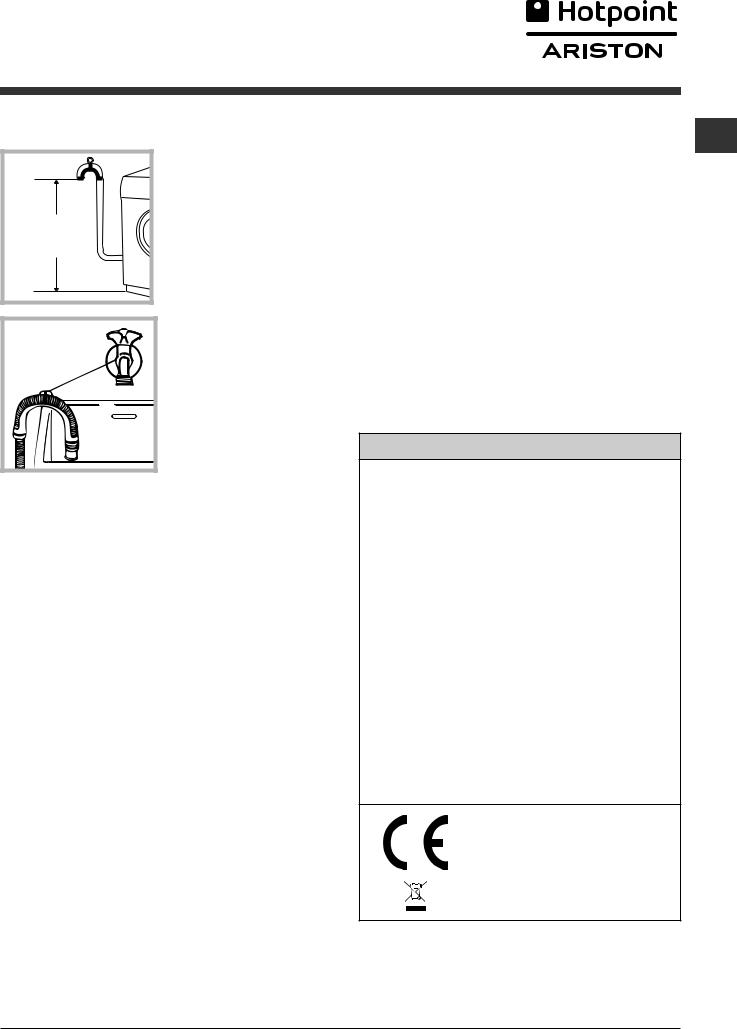
Připojení vypouštěcí hadice
65 - 100 cm |
Připojte vypouštěcí hadici k odpadovému potrubí nebo
k odpadu ve stěně, který se nachází od 65 do 100 cm nad zemí; zamezte jejímu ohybu
nebo ji uchyťte k okraji umývadla či vany a připevněte
ji ke kohoutu
prostřednictvím
držáku
z příslušenství (viz
obrázek). Volný
konec vypouštěcí
hadice nesmí zůstat ponořený do vody.
! Použití prodlužovacích hadic se nedoporučuje; je-li však nezbytné, prodlužovací hadice musí mít stejný průměr jako originální hadice a její délka nesmí přesáhnout 150 cm.
Připojení k elektrické síti
Před zasunutím zástrčky do zásuvky se ujistěte, že:
• Je zásuvka uzemněna a že vyhovuje normám;
• je zásuvka schopna snést maximální zátěž odpovídající jmenovitému příkonu zařízení, uvedenému v tabulce s technickými údaji
(viz vedle);
• hodnota napájecího napětí odpovídá údajům uvedeným v tabulce s technickými údaji (viz vedle);
• je zásuvka kompatibilní se zástrčkou pračky. V opačném případě je třeba vyměnit zásuvku nebo zástrčku.
! Pračka nesmí být umístěna venku – pod širým nebem, a to ani v případě, že by se jednalo o místo chráněné před nepřízní počasí, protože je velmi nebezpečné vystavit ji působení deště a bouří.
! Po definitivní instalaci pračky musí zásuvka zůstat snadno přístupná. CZ ! Nepoužívejte prodlužovací kabely a
rozvodky.
! Kabel nesmí být ohnutý ani stlačený.
! Výměna kabelu musí být svěřena výhradně autorizovanému technickému personálu.
Upozornění! Výrobce neponese žádnou odpovědnost za následky nerespektování uvedených předpisů.
První prací cyklus
Po instalaci zařízení je třeba ještě předtím, než je použijete na praní prádla, provést jeden zkušební cyklus s pracím prostředkem a bez náplně prádla nastavením pracího programu „Samočištění“ (viz “Čištění pračky”).
Technické údaje
Model |
FMSGN 623 |
|
Rozmìry |
šíøka |
59,5 cm |
výška |
85 cm |
|
|
hloubka |
42,5 cm |
Kapacita |
od 1 do 6 kg |
|
Napájení |
Viz štítek s technickými |
|
údaji, aplikovaný na zarí- |
||
|
zení. |
|
|
maximální tlak |
|
Pøipojení k |
1 MPa (10 bar) |
|
minimální tlak |
||
rozvodu vody |
0.05 MPa (0.5 bar) |
|
|
kapacita bubnu 40 litrù |
|
Rychlost |
a¡z do 1200 otáèek za |
|
odstøeïování |
minutu |
|
Kontro- |
program 4; Standardní |
|
lní pro- |
||
gramy podle |
programy pro bavlnu 60°C. |
|
směrnic |
program 5; Standardní |
|
1061/2010 |
programy pro bavlnu 40°C. |
|
1015/2010 |
|
|
Toto zaøízení odpovídá následujícím normám Evropské unie:
- 2004/108/CE (Elektromagnetická kompatibilita) - 2006/95/CE (Nízké napìtí)
- 2012/19/EU
15
